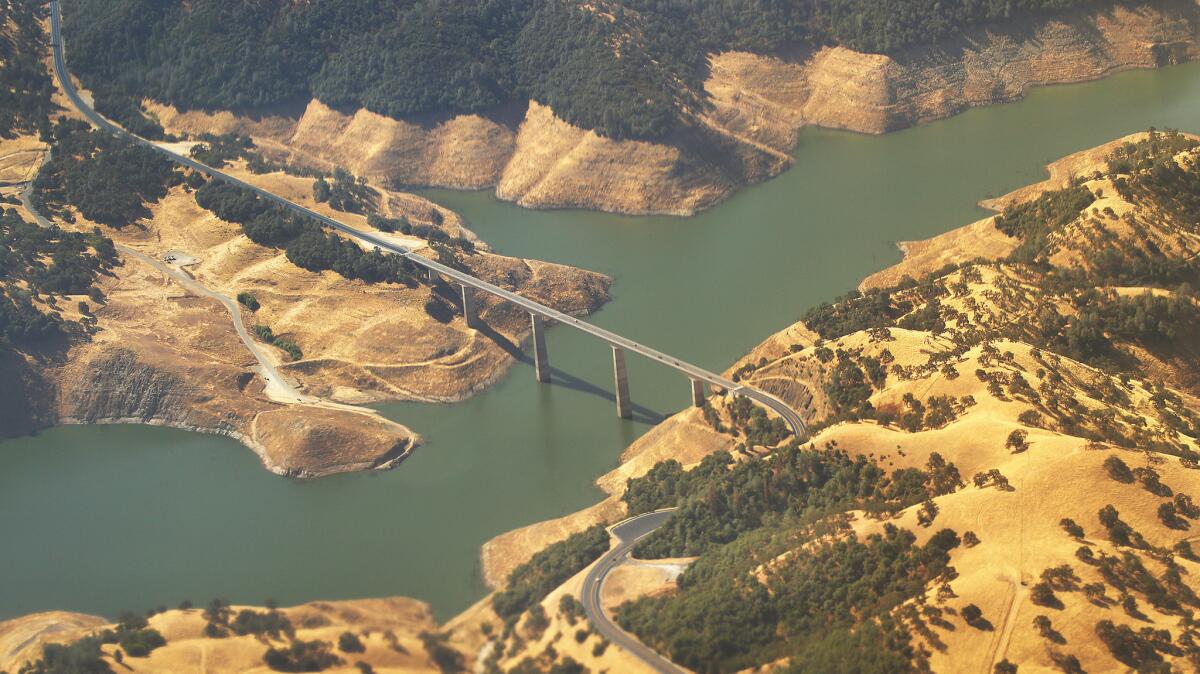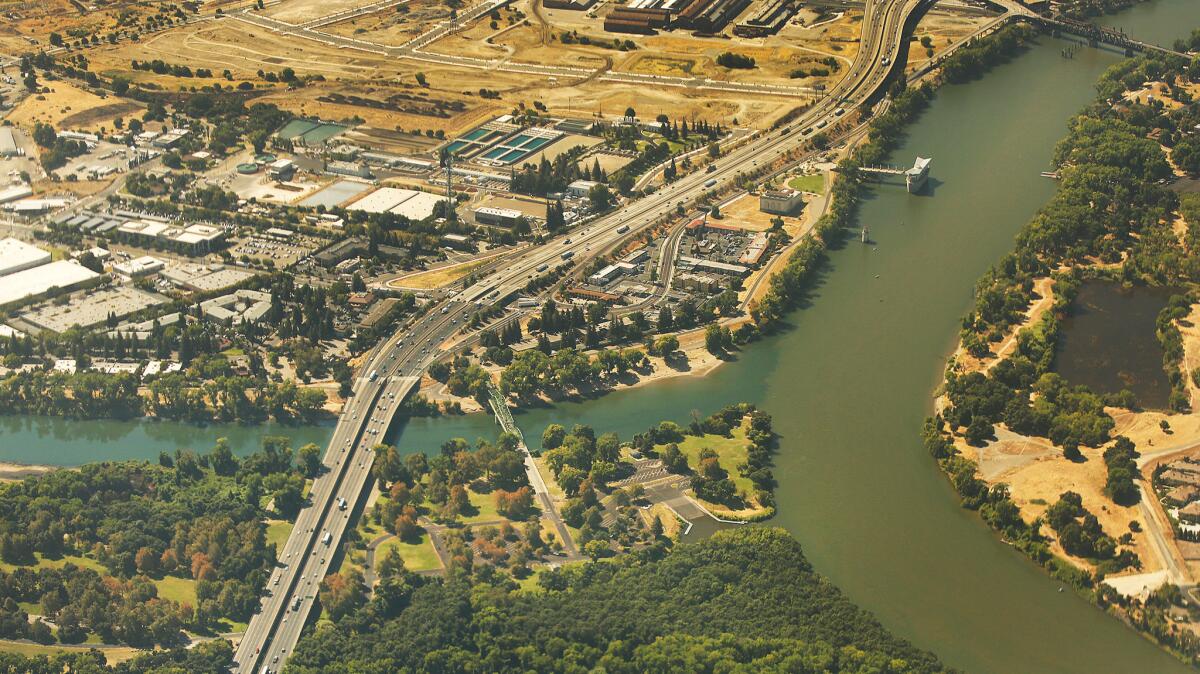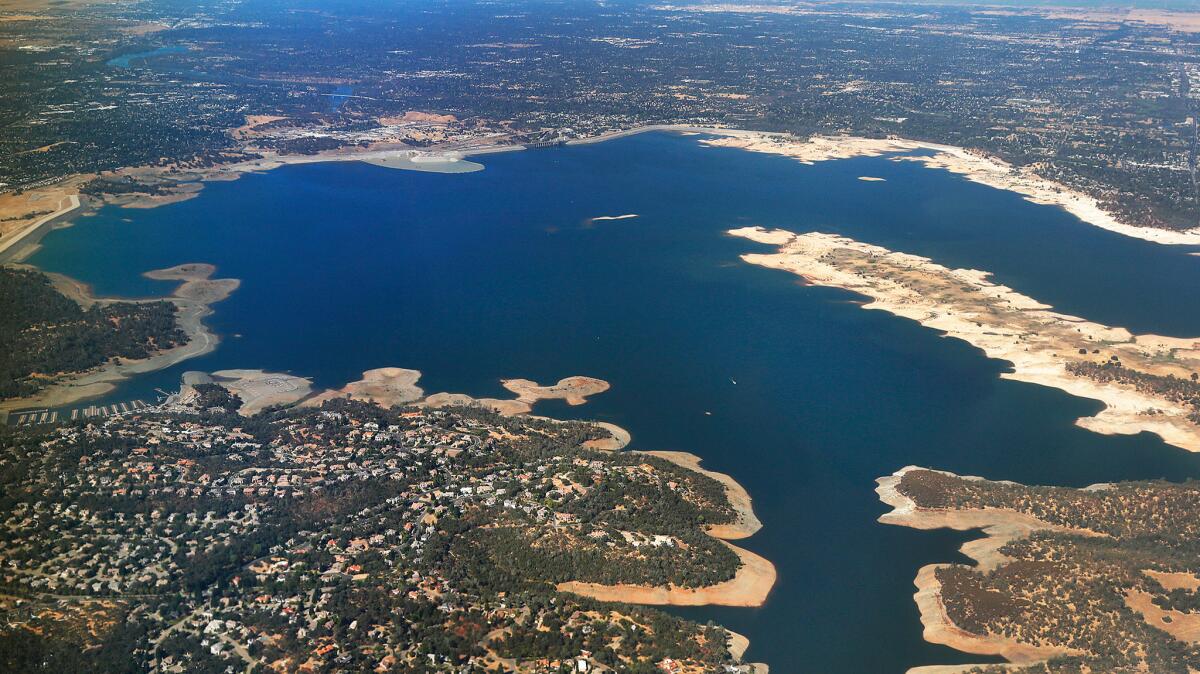A tour of California’s water supply lays bare the tension between farmers and fish

Johnny Amaral, deputy general manager of the Westlands Water Distict
- Share via
Reporting from Fresno — The offer was too tempting to refuse: Westlands Water District, the ethically challenged agency that often finds itself in the news for all the wrong reasons, invited me on an aerial tour of its watershed.
From high above, I would be able to see the public works projects that have allowed the San Joaquin Valley to bloom, cities to explode and the natural environment to implode.
As someone who spends every flight between Los Angeles and Northern California with her nose pressed against the window, checking out reservoir levels, snow lines and lately, plumes of wildfire smoke, how could I say no? The engineering of water is the ultimate California story.
On Monday morning, a small group of us met here at a private airport. We boarded a King Air 200, and flew into the east.

Soon, we were skirting the western edge of the Sierra Nevada, Yosemite’s granite peaks visible in the distance. Suddenly we were over Friant Dam, one of dozens of early- to mid-20th century federal dams, canals and reservoirs designed to transport Northern California’s abundant water to the dry but fertile San Joaquin Valley.
Friant harnessed the flow of the San Joaquin River, which was great for farmers. But it was a disaster for the river, and its Chinook salmon, which will probably never recover.
We flew over dams and reservoirs — Don Pedro, New Melones, Pardee, Camanche — and finally got to Folsom Dam, east of Sacramento, circling to get a good look at Folsom’s new spillway, which will prevent the kind of flooding that happened when a gate failed in 1995, dumping half the reservoir’s water into the American River.

We followed the American River to its confluence with the Sacramento River, then turned south for a bird’s-eye view of the massive Sacramento-San Joaquin Delta, an ecologically fragile estuary that is the struggling heart of California’s complex water system.
Every dammed river, every man-made lake, spoke volumes about the lengths we go to provide water to places that have none.
Ninety minutes after takeoff, our pilot, Tim Brewer, put down in tiny Byron, at the southern edge of the delta. We drove over to the Jones Pumping Plant, site of those six infamous pumps whose 22,500-horsepower motors cause rivers to run backward, imperil endangered fish and, of course, bring fresh delta water to farmers and cities in the Central Valley and Southern California.
Not much was going on here Monday. Only one pump whirred; the rest were idle. Bad news for farmers, good news for fish.
After lunch, we headed south, following the California Aqueduct and the Delta-Mendota Canal, circled over the San Luis Reservoir near Los Banos, then returned to Fresno.
::
Our tour was arranged by Johnny Amaral, Westlands deputy general manager, and a former chief of staff to Republican U.S. Rep. Devin Nunes, who has often, and loudly, accused “radical environmentalists” of plotting to put an end to agriculture in the San Joaquin Valley.

I like Amaral. He is warm and funny, though he has fully internalized his former boss’ suspicions toward people who, as he puts it, “have a political ax to grind against agriculture, who would like to see us gone.”
He is well aware that Westlands, the biggest water agency in the country, has an image problem. Quite apart from larger, practical questions about how many of its water-challenged, drainage-challenged acres should even be cultivated, Westlands is beset by other self-inflicted wounds, ranging from an unprecedented Securities and Exchange Commission fine for what its manager called “a little Enron accounting” to the recent revelation that it spent more than a million dollars creating a Latino farmworkers group that posed as a grassroots organization.
A tour isn’t going to dispel that kind of bad press, but Amaral hoped it would at least function as a corrective to the idea that California does not have enough water to meet all of its needs.
“I like people to be able to see with their own eyes that the state is not out of water because of lack of rainfall or snow pack,” he said. “The state is out of water because it’s simply being mismanaged. Too much is being allowed to flow out to sea.”
Our tour guide for the day was Ara Azhderian, water policy administrator for the San Luis & Delta-Mendota Water Authority. Azhderian’s knowledge of the water system is encyclopedic, and his mellow demeanor is a counterpoint to Amaral’s fervor.

“It’s a false choice to break things down between farmers and fish,” said Azhderian, standing in front of a kitschy floor-to-ceiling papier-mâché bas-relief of California’s water system at the Jones Pumping Plant. “We can do better for fish and fishermen, and we can do better for farms.”
Both he and Amaral told me repeatedly that farmers should not be made to suffer for declining delta fish populations when invasive predators and lousy water treatment practices by cities such as Sacramento and Stockton have contributed equally to the problem.
“The stated reason they are curtailing the pumping is to protect the fish, but all the data shows that hasn’t worked,” Amaral said. “It’s absurd that we are even having this discussion.”
Or is it?
::

On Tuesday, in a pointed though coincidental answer to Amaral, a trio of environmental groups sent a dire letter to the State Water Resources Control Board demanding it take emergency measures to prevent what they describe as the imminent extinction of the delta smelt.
Far too little fresh water, the groups said, is flowing from the delta out to sea, allowing salty water to encroach on the habitat of the smelt, whose population has plunged from an estimated 112,000 a year ago to about 13,000 today.
The letter, signed by officials from Defenders of Wildlife, the Natural Resources Defense Council and the Bay Institute, urges the board to immediately curtail diversions of fresh water from the delta through the end of summer.
“This water we are calling for is essential for the delta smelt,” said Rachel Zwillinger, water policy advisor for Defenders of Wildlife, “but it would benefit countless other species that are struggling.”
So here you’ve got a rare area of agreement. Both sides believe the state’s water has been badly managed — one to the detriment of farmers, the other to the detriment of fish.
I’m not sure I saw exactly what Amaral wanted me to see from the air. Yes, despite normal rainfall this year, there are many fallowed brown fields. And yes, the San Luis Reservoir, which supplies water to Westlands, looked perilously low.
But farmers — most of them anyway — are hardly in danger of extinction. The same, by contrast, cannot be said for the fish.
Twitter: @AbcarianLAT
ALSO
State is years behind on projects to protect wildlife at Salton Sea, officials and activists say
SoCal hit with worst smog in years as hot, stagnant weather brings surge in hospital visits
Lawmakers weaken bill to ban behind-the-scenes communications at Coastal Commission
More to Read
Sign up for Essential California
The most important California stories and recommendations in your inbox every morning.
You may occasionally receive promotional content from the Los Angeles Times.













